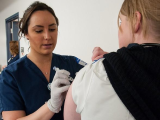Aug 10, 2007 (CIDRAP News) – Global health officials have long feared genetic changes that would make the H5N1 avian influenza virus more easily transmissible among humans, but a new report from researchers at the National Institute of Allergy and Infectious Diseases (NIAID) predicts some of the crucial mutations, which could open the door to preemptive vaccines and treatments.
The report, published in today's issue of Science, details the work of a research group led by Gary Nabel, MD, PhD, director of NIAID's Dale and Betty Bumpers Vaccine Research Center. The group created mutations in the region of the H5N1 hemagglutinin protein that directs the virus to bird or human receptor cells and elicits antibodies to it, according to a NIAID press release yesterday.
"What Dr Nabel and his colleagues have discovered will help prepare for a future threat," said National Institutes of Health director Elias A. Zerhouni, MD, in the press release. "While nobody knows if and when H5N1 will jump from birds to humans, they have come up with a way to anticipate how that jump might occur and ways to respond to it."
Typically, producing a vaccine to protect against H5N1 or another influenza virus strain is a laborious process that can take up to 6 months after a pandemic strain emerges. Scientists must isolate the strain, grow it in eggs or cell culture, and combine the purified virus with other vaccine components.
However, Anthony Fauci, MD, director if NIAID, said in the press release that researchers' findings on the artificially mutated viruses enable scientists to start considering the design of new vaccines and therapies to treat people who may someday be infected with an avian influenza virus that naturally mutates into a pandemic strain.
"This research could possibly help to contain a pandemic early on," he said.
Nabel's group focused on mutations that allow the H5N1 virus to better recognize and enter human cells, the press release said. To determine what mutations allow the virus to shift its adaptability, they compared proteins on the surface of the H5N1 virus, which are bird-adapted, with surface proteins on the human-adapted virus that caused the 1918 pandemic.
Focusing on genetic changes to one portion of the H5 protein, called the receptor binding domain, they found that as few as two mutations could enhance the ability of H5N1 to recognize human cells, according to the press release.
Nabel cautioned in the press release, however, that more mutations would likely be needed for the H5N1 virus to more easily spread between humans. He emphasized that the mutations he and his colleagues identified are probably just a subset of that dangerous group.
To assess how the immune system responds to the mutated H5N1 viruses the authors ran mouse studies, which revealed that mouse antibodies were 10 times less potent against the mutants. Then they created vaccines and isolated new antibodies that might be used to fight the mutated virus, the press release stated. When they vaccinated the mice, they identified one broadly reactive antibody that could neutralize both the bird- and human-adapted H5N1 virus forms.
The findings should improve H5N1 surveillance, Nabel said, because they make it easier for scientists to recognize dangerous mutations and identify structure-based vaccine candidates that might be more effective against the virus before it emerges.
"Insight into the structure of the avian flu virus has enabled us to target a critical region of HA [hemagglutinin] that directs its specificity," he said in the press release. "Such a structure-based vaccine design may allow us to respond to this future threat in advance of an actual outbreak."
Yang ZY, Wei CJ, Kong WP, et al. Immunization by avian H5 influenza hemagglutinin mutant with altered receptor binding specificity. Science 2007 Aug 10;317(5839):825-8 [Abstract]
See also:
Aug 9 NIAID press release
http://www.niaid.nih.gov/news/newsreleases/Archive/2007/Pages/nabel_flu.aspx



















